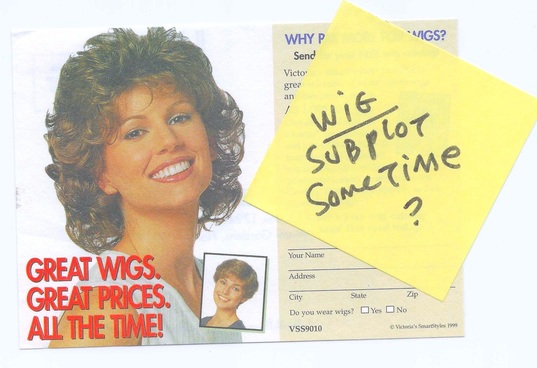 Sarah must've sent me this. That's her handwriting on the Post-it.
Sarah must've sent me this. That's her handwriting on the Post-it. I'm cleaning out my file cabinets this week, which goes quickly until I get to the drawer with folders labeled "Great Writing!" and "Inspiration" and "Grist." This is where I find ads for wigs and a newspaper article about a man in Arkansas who claims he's addicted to elephants. I also have articles torn out from The New Yorker about roving reporter Emily Hahn (my hero!) and another titled "The Art of Failing" by James Atlas. It's from 1998, but I just reread it and enjoyed it all over again.
Something else I have from 1998: An article torn from the New York Times Magazine titled, "How to Manufacture a Best Seller." In it, the author tells the tale of three guys named John who set out to crack the code on blockbuster fiction. They came up with a formula, wrote a book based on it called The Eleventh Plague, and walked away with a $3 million deal. Here's their formula for crafting a multi-million dollar thriller:
1. The hero must be an expert.
2. The villain must also be an expert.
3. You must watch all of the villainy over the shoulder of the villain.
4. The hero has a team of experts in various fields behind him. (KK note: Or behind her.)
5. Two or more on the team must fall in love.
6. Two or more on the team must die.
7. The villain must turn his (KK: or her) attention from his initial goal to his team. (KK note: Seems to me this is what the hero does, not the villain. But what do I know?)
8. The villain and the hero must live to do battle again in the sequel.
9. All deaths must proceed from the individual to the group. (KK note: Huh?)
10. If you get bogged down, just kill somebody.
I just looked up these guys' book on Amazon. It's out of print. (Kirkus called it "gripping if styleless.") Oh well. But their formula is interesting because at first glance, it seems like the exact formula used in "Scandal", the TV show I've been watching this summer with guilty pleasure.
Of course, formulas aren't the key to good writing. We all know that. But they're fun to try on once in a while. Kinda like a wig, right?
Something else I have from 1998: An article torn from the New York Times Magazine titled, "How to Manufacture a Best Seller." In it, the author tells the tale of three guys named John who set out to crack the code on blockbuster fiction. They came up with a formula, wrote a book based on it called The Eleventh Plague, and walked away with a $3 million deal. Here's their formula for crafting a multi-million dollar thriller:
1. The hero must be an expert.
2. The villain must also be an expert.
3. You must watch all of the villainy over the shoulder of the villain.
4. The hero has a team of experts in various fields behind him. (KK note: Or behind her.)
5. Two or more on the team must fall in love.
6. Two or more on the team must die.
7. The villain must turn his (KK: or her) attention from his initial goal to his team. (KK note: Seems to me this is what the hero does, not the villain. But what do I know?)
8. The villain and the hero must live to do battle again in the sequel.
9. All deaths must proceed from the individual to the group. (KK note: Huh?)
10. If you get bogged down, just kill somebody.
I just looked up these guys' book on Amazon. It's out of print. (Kirkus called it "gripping if styleless.") Oh well. But their formula is interesting because at first glance, it seems like the exact formula used in "Scandal", the TV show I've been watching this summer with guilty pleasure.
Of course, formulas aren't the key to good writing. We all know that. But they're fun to try on once in a while. Kinda like a wig, right?